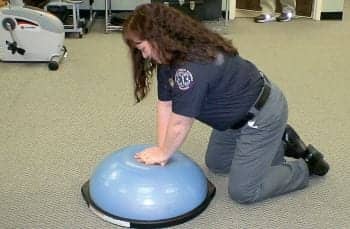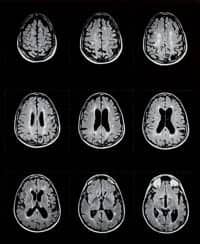 |
According to the National Institutes of Health (www.nih.gov), back pain is one of the most common medical problems, affecting eight out of 10 people at some point during their lives.1 Back pain can range from a dull, constant ache to a sudden, sharp pain or be acute, coming on suddenly. Then there are the chronic sufferers.
The lower back is the most common site of back injuries and back pain, which include sprains, strains, herniated disks, and fractured vertebrae. It is no wonder our clients are constantly seeking a treatment regimen that works. Although there is never an overall cure, we will be discussing a variety of noninvasive prevention and treatment modalities.
BACK INJURIES AND AQUATIC THERAPY
In terms of aquatic therapy for back pain/injuries, Jim Kittelberger, MPT, of The Physical Therapy Center (www.handsoncare.net) in Pittsburgh, says that water exercise is used to mobilize joints, increase range of motion, and develop balance and stability. The special properties of water can provide excellent benefits if a client is trying to heal a back injury. Being in water provides a safe environment for working out muscles and stretching the body. It eliminates the constraints imposed by gravity, strengthens muscles, decreases pain, and increases flexibility.
The Physical Therapy Center’s counter-current aquatic and rehabilitation pool starts with little or no water resistance. Patients in initial stages of rehabilitation begin therapy sooner due to the buoyancy of water. Progression begins with non-weight-bearing activities and increases to different levels of partial weight-bearing. The use of variable depths and increasing water resistance measures a patient’s progress, which can extend into a full range of training and conditioning all without damaging stress on muscles, joints, and bones. Additionally, the pool offers a stress-free workout of all major muscle groups as well as the cardiovascular and respiratory systems. Kittelberger specializes in orthopedics and sports physical therapy.
Kittelberger says that aquatic equipment complements the special properties of water and creates further benefits such as increasing the resistance and giving patients a harder workout.
There are some situations when water exercise is not an appropriate activity. Kittelberger finds some clients are “frightened of the water and often have to overcome that. Some have allergies to chlorine or have a fear of their head going under water,” he adds.
STABILIZE THE CORE, LESSEN THE PAIN
“Why Pilates is so effective for back pain is that it is one of the only exercise systems that takes an integrated approach to how you train the muscles in the body,” says Dawn-Marie Ickes, MPT, at Core Conditioning (www.coreconditioningpt.com) in Burbank and Studio City, Calif. “The primary focus of most of the exercises in the repertoire is based on the deep abdominals and the spinal stabilizer functions with appropriately utilizing the diaphragm and the pelvic floor musculature,” she explains. At Core Conditioning, they use a whole-body approach to rehabilitation and have helped injured patients of all kinds recover quickly and achieve a level of strength, stability, and mobility they may not have had even prior to their injury.
Pilates focuses on alignment and facilitates improved posture. “The nice thing about Pilates is because many of the exercises are coordinating breathing with lifted posture, a lifted sternum, an elongated spine, and supporting the abdomen, over time, people stand taller. Postural dysfunction is one of the leading causes, if not the number one cause, of back pain in America,” Ickes states. Also, she says, when you maintain the normal curvature of the spine, you will have improved back health. Pilates is so focused on proper alignment, having your pelvis in a neutral position, your shoulders relaxed, and your neck lengthened, it’s actually promoting the preservation of those curves and minimizes the stress on all those structures as well. “If your hip musculature, ie, hamstrings, glutes, and hip flexors, is really tight and restricted, that will also put you at increased risk for back injury,” Ickes says.
Ickes says she’s had patients who were injured by Pilates, meaning, however, that they had a spinal problem and they went to a Pilates class because they read an article about it that said it was the best thing for people with chronic low back pain. “They had an instructor who was not comprehensively trained or lacked an understanding of the different types of back pain diagnoses,” she says. That’s where someone can be at increased risk. As a physical therapist (and certified in Pilates), Ickes treats the gamut—everything from spinal stenosis to herniated disks. “You just have to have that person work in a completely neutral spinal alignment, and that means they don’t go into too much lumbar flexion or extension.” All instructors going through Core’s training program know that you teach in neutral for a month especially with patients who are nonspecific and don’t have a diagnosis.
TAPING: THERAPEUTIC AND FUNCTIONAL
Taping is considered a therapeutic, functional form of taping. According to Kittelberger, “[Through the use of therapeutic taping], we have been able to assist in the alleviation of low back pain, which is so common today. Therapy taping offers support, encouraging range of motion and use, and provides proprioceptive feedback, which promotes alleviation of pain and lymphatic channeling of fluids to bring down any swelling and/or edema (postacute or postoperative),” he continues. The four primary functions of therapy taping are that it corrects muscle function, realigns joints, channels circulatory fluids, and alleviates pain.
Although the method is proven safe and effective, this information is provided in a general nature to help the physician/therapist and the patient in their mutual quest for health.
ELECTROTHERAPY CAN ELIMINATE BACK PAIN
“Electrotherapy can ‘block’ pain signals, thus allowing individuals/patients to do easy exercises, walk, or move around,” says Tom Watson, DPT, MED, DAAPM, of Peak Performance Physical Therapy (www.peaktherapy.net) in Redmond, Ore. “It can also drive in steroids, analgesics, and opioid compounds to the underlying pain sites.”
Transcutaneous electrical nerve stimulation (TENS) is a method of pain relief in which a special apparatus transmits low-voltage electrical impulses through electrodes on the skin to an area of the body that is in pain. Evidence suggests that TENS may help reduce certain types of pain (particularly mild) for a short period of time, but it does not appear to reduce chronic pain. A TENS system consists of an electrical power unit connected by wires to a pair of electrodes. The electrodes are attached to the patient’s skin near the source of pain. When the unit is switched on, a mild electrical current travels through the electrodes into the body. Patients may feel a prickling sensation or warmth during treatment. A session typically lasts from 5 to 15 minutes, and treatments may be applied as often as necessary, depending on the severity of pain.
TENS is used widely by physical therapists and other medical practitioners but also can be performed at home by patients using a portable TENS system. More than 100 types of TENS units are approved for use by the FDA.
TENS is generally considered safe. However, electrical current that is too intense or used incorrectly can burn or irritate the skin. The electrodes should not be placed over the eyes, heart, brain, or front of the throat. People with heart problems should not use TENS. People with allergies to adhesives may react to the electrode pads. Those with implanted pacemakers, defibrillators, infusion pumps, and other such devices should avoid this treatment method.
Cranial electro stimulation (CES) is FDA approved and may be safely used through the skull. When applied to the earlobes, it has a profound effect on the brain stem, causing a significant increase in the release of serotonin and dopamine. “These neuro-chemicals can modulate or block pain information to or from the brain, produce relaxation, and facilitate sleep improvement. It can also stop many types of headaches,” Watson says. “TENS is measured in milliamps; CES or microstim is measured in microamps based on the Arndt-Schultz principle: a weak impulse (CES or microstim) produces a long-lasting effect on the body, and a strong impulse produces a brief intense effect on the body (TENS, IFC, or galvanic stim),” he explains. TENS is considered a low-frequency device. There are no known contraindications to CES.
Interferential current (IFC) is a medium-frequency device designed in the mid 1980s to overcome electrical resistance at the skin level. TENS penetrates up to 1 inch. IFC penetrates at 1 to 2 inches depending on the information source. “The four electrodes are placed in an ‘x’ pattern so the impulses from the two electrodes interfere or cross and a vector pattern is set up,” Watson adds. “This current manages pain but has no curative value.”
ULTRASOUND & HOT/COLD THERAPIES
When applied, ultrasound is used just for heating deep tissue. It is only useful for areas that are approximately two times the size of the [ultrasound] head. “So it is generally a very small area that may be treated,” says Brian A. Mock, MPT, SCS, COMT, CSCS, at Centers for Rehab Services, UPMC Centers for Sports Medicine (www.upmc.edu) in Pittsburgh. “It is used primarily as a precursor to deep tissue massage, trigger point release, or soft tissue stretching,” he says. “When attempting to increase blood flow or heat deeper muscles in large areas such as the entire low back, other modalities such as diathermy may be more appropriate.”
Along with electrical stimulation, heat and ice are common modalities used as an adjunct to physical therapy treatments. “Regardless of the condition, heat is generally used to warm up or relax a muscle prior to treatment. Ice is generally the better modality for an acute or active inflammatory process,” Mock says. “In acute conditions where exercise may be contraindicated, the principles of rest, ice, compression, and elevation should be followed. Heat and ice are generally not used as the primary treatments.”
Heat is used to warm up the muscles or area to be treated by increasing blood flow. It may serve as a good adjunct to reduce spasm or help relax the muscles prior to manual therapy techniques. “It can be administered multiple times throughout the day, not to exceed 20 to 30 minutes,” Mock states. Cold is used as in any other pathology and generally during a painful or inflammatory acute episode of injury. It is also administered throughout the day, not to exceed 20 to 30 minutes.
“Caution is to be used in the case of malignancy and in certain vascular or skin conditions. When using heat or cold, it is appropriate to use proper layering and monitor the skin for signs of irritation,” Mock concludes.
TRANSDERMAL DELIVERY PAIN RELIEF
Iontophoresis is a part of electrotherapy. “It’s a transdermal delivery system for driving medication, vitamins, and proteins, which are applied to a conductive electrode and, depending on the polarity of the solution, into the underlying tissue,” Watson explains. “Various analgesics, steroids (dexamethasone), antibiotics, muscle relaxants, experiments with antiseizure medications, and chemical elements are used,” he says. Side effects or contraindications include skin reaction or allergy to the solution used.
Some therapists do not think that dexamethasone or local anesthesia iontophoresis is particularly effective in treating back injuries because of the depth of the inflamed soft tissue and the relatively large areas involved.
Nina Silberstein is a contributing editor for Rehab Management. For more information, please contact .
REFERENCE
- Back pain. National Institutes of Health, National Institute of Arthritis and Musculoskeletal and Skin Diseases. www.nlm.nih.gov/medlineplus/backpain.html. Accessed July 13, 2008.





